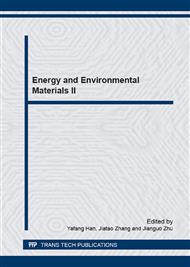[1]
B. Wang, R. Liang, B. Wang, et al. Dispersion and thermal conductivity of carbon nanotube composites. Carbon. 2009, 47(53-57).
DOI: 10.1016/j.carbon.2008.08.024
Google Scholar
[2]
S. Wang, R. Liang, B. Wang, et al. Load-transfer in functionalized carbon nanotubespolymer composites. Chem Phys Lett. 2008, 457(371-375).
Google Scholar
[3]
P. Guo, X.H. Chen, X.C. Gao, et al. Fabrication and mechanical properties of well-dispersed multiwalled carbon nanotubes/epoxy composites. Compos Sci Technol. 2007, 67(3331-3337).
DOI: 10.1016/j.compscitech.2007.03.026
Google Scholar
[4]
S.M. Yuen, C.M. Chen, H.H. Wu, et al. Preparation and thermal, electrical, and morphological properties of multiwalled carbon nanotubeand epoxy composites. J Appl Polym Sci. 2007, 103(1272-1278).
DOI: 10.1002/app.25140
Google Scholar
[5]
L. Guadagno, B. Vivo, A. Bartolomeo, et al. Effect of functionalization on the thermo-mechanical and electrical behavior of multi-wall carbon nanotubeepoxy. Carbon. 2011, 49(1919-1930).
DOI: 10.1016/j.carbon.2011.01.017
Google Scholar
[6]
A. Moisala, Q. Li, I.A. Kinloch, et al. Thermal and electrical conductivity of single- and multi-walled carbon nanotube-epoxy composites. Compos Sci Technol. 2006, 66(1285-1288).
DOI: 10.1016/j.compscitech.2005.10.016
Google Scholar
[7]
P.C. Ma, S.Y. Mo, B.Z. Tang, et al. Dispersion, interfacial interaction and re-agglomeration of functionalized carbon nanotubes in epoxy composites. Carbon. 2010, 48(1824-1834).
DOI: 10.1016/j.carbon.2010.01.028
Google Scholar
[8]
A.B. Sulong, N. Muhamad, J. Sahari, et al. Electrical conductivity behaviour of chemical functionalized MWCNTs epoxy nanocomposites. European Journal of Scientific Research. 2009, 1(29): 13-21.
Google Scholar
[9]
I.D. Rosca, S.V. Hoa. Highly conductive multiwall carbon nanotube and epoxy composites produced by three-roll milling. Carbon. 2009, 47(1958-1968).
DOI: 10.1016/j.carbon.2009.03.039
Google Scholar
[10]
J. Li, P.C. Ma, W.Z. Chow, et al. Correlations between percolation threshold, dispersion state, and aspect ratio of carbon nanotubes. Adv Funct Mater. 2007, 17(3207-3215).
DOI: 10.1002/adfm.200700065
Google Scholar
[11]
J.K.W. Sandler, J.E. Kirk, I.A. Kinloch, et al. Ultra-low electrical percolation threshold in carbon-nanotube-epoxy composites. Polymer. 2003, 44(5893-5899).
DOI: 10.1016/s0032-3861(03)00539-1
Google Scholar
[12]
W. Bauhofer, J.Z. Kovacs. A review and analysis of electrical percolation in carbon nanotube polymer composites. Compos Sci Technol. 2009, 69(1486-1498).
DOI: 10.1016/j.compscitech.2008.06.018
Google Scholar
[13]
W. Bauhofer, J.Z. Kovacs. A review and analysis of electrical percolation in carbon nanotube polymer composites. Compos Sci Technol. 2009, 69(1486-1498).
DOI: 10.1016/j.compscitech.2008.06.018
Google Scholar
[14]
L. Vaisman, G. Marom, H.G. Wagner. Dispersions of Surface‐Modified Carbon Nanotubes in Water‐Soluble and Water‐Insoluble Polymers. Adv Funct Mater. 2006, 16(357-363).
DOI: 10.1002/adfm.200500142
Google Scholar
[15]
Y. Geng, M.Y. Liu, J. Li, et al. Effects of surfactant treatment on mechanical and electrical properties of CNTepoxy nanocomposites. Composites: Part A. 2008, 39(1876-1883).
Google Scholar
[16]
P.C. Ma, N.A. Siddiqui, G. Maromb, et al. Review Dispersion and functionalization of carbon nanotubes for polymer-based nanocomposites: A review. Composites: Part A. 2010, 41(1345-1367).
DOI: 10.1016/j.compositesa.2010.07.003
Google Scholar
[17]
Y.J. Kim, T.S. Shin, H.D. Choi, et al. Electrical conductivity of chemically modified multiwalled carbon nanotube epoxy composites. Carbon. 2005, 43(23-30).
DOI: 10.1016/j.carbon.2004.08.015
Google Scholar
[18]
F.H. Gojny, H.G. Wichmann, B. Fiedler, et al. Evaluation and identification of electrical and thermal conduction mechanisms in carbon nanotube/epoxy composites. Polymer. 2006, 47(2036-2045).
DOI: 10.1016/j.polymer.2006.01.029
Google Scholar


